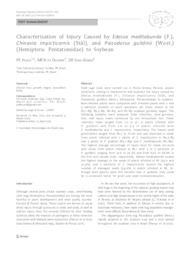Characterization of injury caused by Edessa meditabunda (F.), Chinavia impicticornis (Stål), and Piezodorus guildinii (West.) (Hemiptera: Pentatomidae) to soybean.
Characterization of injury caused by Edessa meditabunda (F.), Chinavia impicticornis (Stål), and Piezodorus guildinii (West.) (Hemiptera: Pentatomidae) to soybean.
Author(s): HUSCH, P. E.; OLIVEIRA, M. C. N. de; SOSA-GÓMEZ, D. R.
Summary: Field cage trials were carried out in Ponta Grossa, Paraná, season 2010/2011, aiming to characterize and evaluate the injury caused by Edessa meditabunda (F.), Chinavia impicticornis (Stål), and Piezodorus guildinii (West.) (Hemiptera: Pentatomidae) to soybean. Non-infested plants were compared with infested plants with 2 and 3 adults/m (number of adult specimens per linear meter) at the R5.1?R9, R5.3?R9, R6?R9, and R7?R9 soybean growing stages. The following variables were analyzed: foliar retention, seed germination, and injury levels estimated by the tetrazolium test. Foliar retention index ranged from 2.3 to 4.1 in plants infested with P. guildinii and from 2.6 to 3.3 in plants infested with E. meditabunda and C. impicticornis, respectively. The lowest seed germination ranged from 66.5 to 76.5% and was observed in seeds from plants infested with 2 adults of C. impicticornis at R5.3?R9 and 3 adults of P. guildinii (R5.1?R9) and E. meditabunda (R7?R9). The highest average percentage of injury level for seeds occurred with seeds from plants infested at R5.1 with 2 or 3 adults/m of P. guildinii, ranging from 22.6 to 25.0% and from 63.6 to 68.0% in the first and second trials, respectively. Edessa meditabunda caused the highest damage to the seeds of plants infested at R7 (34.0 and 41.4%), and 2 adults/m of C. impicticornis caused the highest number of damaged seeds (54.0%) in plants infested at R6. Although both species were less harmful than P. guildinii, they could be a constraint factor for grain and seed commercialization.
Publication year: 2014
Types of publication: Journal article
Unit: Embrapa Soybean
Keywords: Soja
Observation
Some of Embrapa's publications are published as ePub files. To read them, use or download one of the following free software options to your computer or mobile device. Android: Google Play Books; IOS: iBooks; Windows and Linux: Calibre.
Access other publications
Access the Agricultural Research Database (BDPA) to consult Embrapa's full library collection and records.
Visit Embrapa Bookstore to purchase books and other publications sold by Embrapa.

